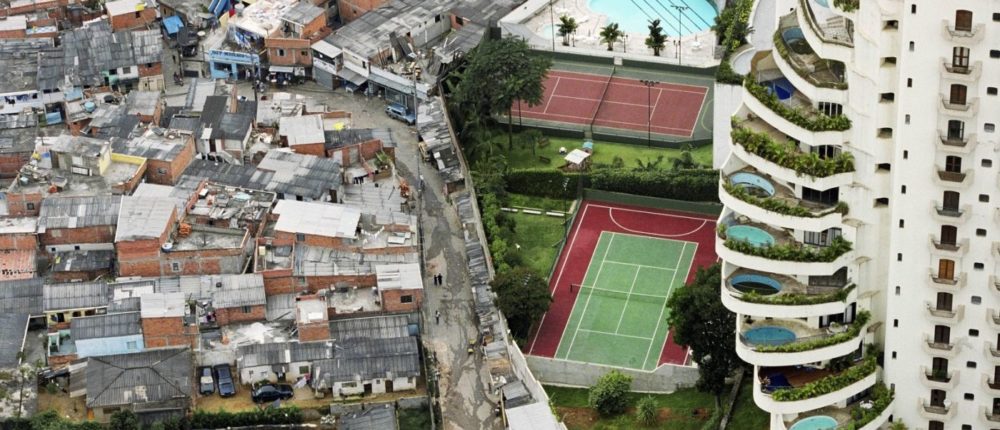
It’s Time for Design Education to Put Social Equity at the Core of Its Mission
In its recently released report on global inequality, Oxfam warned that the world is nearing unprecedented extremes of social inequality, and that power and privilege continues to be used to further skew the global economic system. The report confirms that the richest 1% now has more wealth than the rest of the world combined, and that the eight richest men on the Forbes List have as much wealth as the poorest half of the world.
These startling statistics portend a very troubling future for our world. And in no sphere of our daily life is this glaring wealth gap more acute than in the design of the built environment. Today, urban placemaking and its accompanying disciplines remain the most tangible evidence of social inequality globally. It is, in fact, the first line of our society’s “assault” on its poor, and often the most visible difference between the swanky neighborhoods of the rich and the squalid slums that surround them.
It’s clear that architecture, as a profession, has deprived the poor of far more than it has ever offered them. Most poor people today see the architect as a lethal tool in the hands of the rich.
It’s clear that architecture, as a profession, has deprived the poor of far more than it has ever offered them. Most poor people today see the architect as a lethal tool in the hands of the rich—those on whose account they’re often dispossessed of their homes and forcefully relocated to far-flung places in a bid to accommodate extravagant development projects. Most people in this segment of the social pyramid will probably never use the services of an architect in their entire lifetime, yet as the dominant demographic bloc in our societies, they cannot be ignored. Rather, the inability to reach them poses huge moral and ethical questions for the contemporary architect.
In spite of the worsening social conditions of more than half of the world’s population, architecture education and practice have consistently failed to adapt to, or in some case even acknowledge, this unfolding social calamity. This is in stark contrast to the green building movement, which became a crucial part of practice in the past decade. Presently, environmental sustainability has been firmly built into most design curriculums, and hardly anyone passes through design school these days without receiving a lot of instruction in sustainable design. The design and construction industry has also developed its own environmental best practices, such as LEED (Leadership in Energy and Environmental Design), which is gradually becoming the global industry standard.
Over the years, organizations like Architecture Sans Frontiers (ASF) and Open Architecture (formally Architecture for Humanity), have provided a vehicle for architecture to socially engage with poor communities. The objectives of these groups are laudable, as they provide architectural services for communities who ordinarily couldn’t afford them. While not taking any credit away from the successes of these groups, it is evident that their sphere of influence remains extremely limited. Their areas of focus, as well as the resources available to them, do not in any way reflect the massive social emergency humanity is presently confronted with. Though I believe in the core values of these groups, I find their approach too reactive for a profession as strategic as architecture.
A more proactive strategy would embed the principles of social sustainability into contemporary design education, so as to ensure that the values of groups such as ASF and OA become inseparable from the profession, rather than as “add-ons,” afterthoughts, or subjects for well meaning but ultimately myopic exhibitions. This aspect of architecture education should have the status and importance of sustainable design or even design studio, because it would equip architects with the requisite knowledge and mindset to design appropriately for all social stratas. This would ultimately have a further-reaching impact on humanity than the present way of engaging in selective charity or pro bono work.
What I am proposing here isn’t a prescriptive toolkit for social sustainability in architecture, but rather, a new social blueprint for architecture design and practice, an absolute overhaul of architecture curriculum and practice globally, where social consciousness becomes a core feature of professional practice, when doing otherwise would be noted and treated as professional misconduct. This approach will ensure that architects and designers acknowledge and respond appropriately to the social realities within their immediate communities. For instance, architects and designers must become interested in the conditions under which their designs are realized and the overall welfare of the workforce that brings these designs to fruition. They must ensure that no part of this process upsets social harmony or confers undue advantage on one social class over another, especially with regards to the use of communal resources, such as access roads, water or even legitimate sources of livelihoods.
This new design approach will ensure that every aspect of the design process and its target output, at all times acknowledges the needs of the socially disadvantaged majority, thereby creating a balance that not only ensures equity but also preserves social harmony. This new socially-conscious orientation will highlight a design approach that is attuned to the existing realities of our local communities, rather than the current generic design curriculum that has been passed down across generations.
While some might argue that architects don’t have the kind of leverage to effect sweeping social change, I disagree. The construction industry has been greatly transformed in the past two decades with regards to environmental sustainability; hence we have the power, and the obligation, to do the same for social equity. This approach is even more pertinent today, because the continued exclusion of the global poor from decision-making in the built environment diminishes us all. And I fear that it has the potential to further deepen the already brewing mutual hatred and mistrust between the rich and poor in our communities.
Featured image: Sao Paulo; photo by Tuca Viera, via NextCity.
